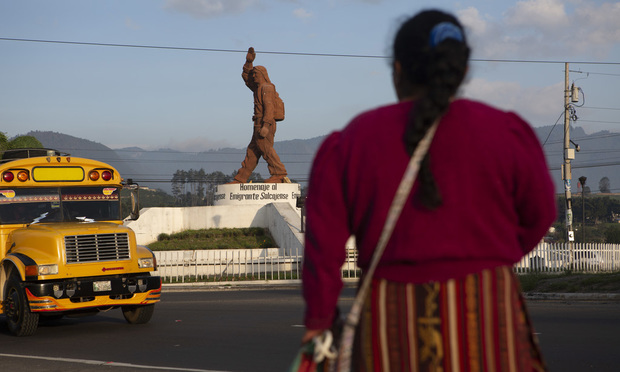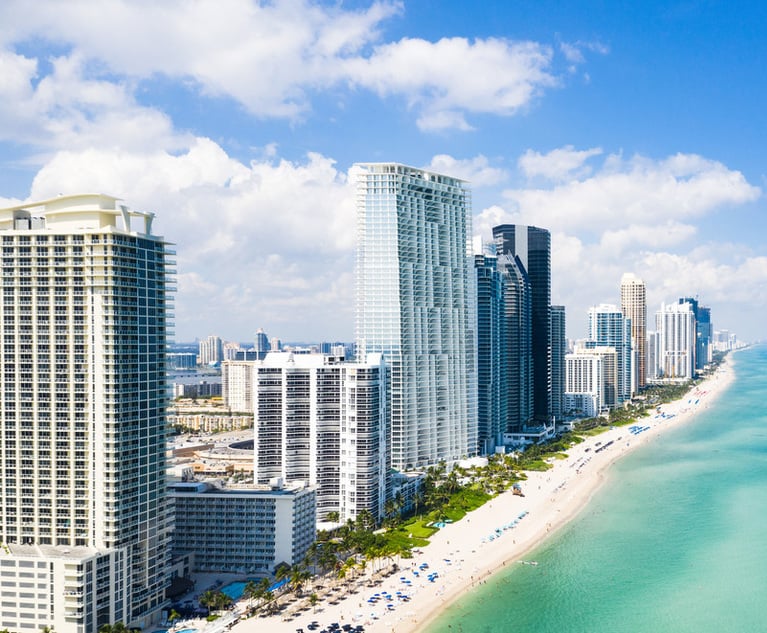Central Americans Pursue US Dream Despite Mexico Crackdown
About 1% of Guatemala's population of some 16 million people have left the country this year, part of a wave of Central Americans fleeing poverty, violence and drought.
June 11, 2019 at 10:32 AM
6 minute read
 A Quiche indigenous woman stands facing a monument that pays homage to migrants from the town of Salcaja, at the entrance to the town in Guatemala. (AP Photo/Moises Castillo)
A Quiche indigenous woman stands facing a monument that pays homage to migrants from the town of Salcaja, at the entrance to the town in Guatemala. (AP Photo/Moises Castillo)
A near-death experience in the Arizona desert a year ago won't deter Francisco Pérez from another attempt to migrate to the U.S., nor will an increased police presence in southern Mexico.
The 23-year-old Guatemalan teacher and auto mechanic hopes to set out again soon to repay the $7,000 he owes from his first trip, when he and two other young men got lost for a week in the desert before being rescued by the U.S. border patrol.
On the seventh day, facing severe dehydration, the group resorted to drinking their own urine.
“Each of us urinated in a bottle and then strained it with the corner of our pants,” said Pérez, rubbing his hands together as he recalled the day he thought would be his last.
Pérez spent two days in a U.S. hospital before being returned to Guatemala. During his short stay in Arizona, though, he caught a glimpse of houses with manicured lawns, orderly roads and fancy stores. Those images are like a siren's song, calling him to what he believes would be a better life.
Before setting out for the U.S., he earned $100 a month as a teacher and had a girlfriend. Now she is with somebody else and he's helping out in his father's auto repair shop in his hometown of San Marcos, just a few miles from the border with Mexico.
“In the end I lost everything,” Pérez said.
Mexico deployed 6,000 National Guard troops to its southern border on Monday to deter Central Americans from trekking toward the American dream. About 1% of Guatemala's population of some 16 million people have left the country this year, part of a wave of Central Americans fleeing poverty, violence and drought.
U.S. Border Patrol agents apprehended 132,887 migrants in May, the highest monthly figure in more than a decade. Many Central American migrants in recent months have been requesting asylum. The United States has returned more than 10,000 U.S. asylum seekers to Mexico since January under a program that requires migrants to wait in that country while their cases wind through U.S. courts. Thousands of Central Americans have also applied for asylum to start new lives in Mexico.
On Friday, Mexican officials vowed to step up migration enforcement to avoid U.S. tariffs on all Mexican imports. Increased enforcement could mean more inspections of buses, raids on hotels and arrests to disrupt people-smuggling networks. Last week, Mexico arrested two migration activists and froze the accounts of more than two dozen people alleged to have organized caravans.
“We are really in front of a humanitarian tragedy,” Mexico's ambassador to the U.S., Martha Bárcena, told CBS News' “Face the Nation” on Sunday.
Most Central American migrants come from rural areas, Bárcena noted, suggesting that Mexico and the U.S. should work together to address the root causes of migration rather than just enforcement.
Not far from San Marcos, in the mountain hamlet of La Union Los Mendoza, about one in three people has migrated, according to community leader Genaro Méndez. The rural town of 600 families has dirt roads that turn to mud during the rainy season. Most of its residents subsist on beans, corn and other food that they can grow. Most homes lack running water.
Méndez himself spent 18 years working in the U.S. as an electrician. He decided to remain in La Union Los Mendoza after he was deported for a second time, in 2016.
Now, young men from this indigenous Mam community come to the 43-year-old Méndez for advice on how to make it up north.
“The laws are a little hard” in the U.S., he tells them. “They don't receive you well.”
And the journey itself is fraught with perils. “It's not, 'Grab your backpack and go,' ” Méndez warns.
Two Honduran migrants told The Associated Press on Sunday that they were robbed by Mexican officials of the little cash they had while on a bridge between Guatemala and Mexico. The migrants jumped into the Suchiate River to flee from the officials, who they said confiscated their identification documents, beat them and asked them for bribes to pass into Mexico.
“ There's tremendous corruption here,” said one of the men, Jose Romero, fighting back tears. “It's sad to see all the Central American countries, instead of being united and helping us, they take the little that we have.”
Romero said his hometown of San Pedro Sula has become too violent and that work there is scarce. He said he'd take asylum from Mexico or any other country willing to offer him refuge.
“We're honest, clean people, determined to work,” Romero said.
Back in Pérez's hometown of San Marcos, there are restaurants, schools, stores and a picturesque central plaza rimmed by misty mountains. But the money he can earn there, he said, would be barely enough to get by. Grinding poverty sends many in Guatemala in search of higher incomes in the U.S. Pérez's own father lived in the U.S. for nine years before being deported.
“I'm not going to lie, when I left the desert I left with fear,” Pérez said. “I said, 'I'm not coming back here.' ”
But a year later, he's trying to make financial arrangements to set out again.
Buses roll out of San Marcos every day from stations lined with backpacks for sale to those making the journey north. Since Pérez hopes to secure a job in the U.S. that allows him to send money back to his aging parents, he tunes out warnings of an increased police presence in Mexico.
“ I wouldn't rule out going back,” he said.
Sonia Perez D. reports for the Associated Press.
This content has been archived. It is available through our partners, LexisNexis® and Bloomberg Law.
To view this content, please continue to their sites.
Not a Lexis Subscriber?
Subscribe Now
Not a Bloomberg Law Subscriber?
Subscribe Now
NOT FOR REPRINT
© 2025 ALM Global, LLC, All Rights Reserved. Request academic re-use from www.copyright.com. All other uses, submit a request to [email protected]. For more information visit Asset & Logo Licensing.
You Might Like
View All
Winston & Strawn Snags Sidley Austin Cross-Border Transactions Partner in Miami
2 minute read
Miami’s Arbitration Week Aims To Cement City’s Status as Dispute Destination
3 minute read
Brazil Is Quickly Becoming a Vital LatAm Market for Greenberg Traurig, Other US Law Firms
5 minute readTrending Stories
- 1Stevens & Lee Names New Delaware Shareholder
- 2U.S. Supreme Court Denies Trump Effort to Halt Sentencing
- 3From CLO to President: Kevin Boon Takes the Helm at Mysten Labs
- 4How Law Schools Fared on California's July 2024 Bar Exam
- 5'Discordant Dots': Why Phila. Zantac Judge Rejected Bid for His Recusal
Who Got The Work
Michael G. Bongiorno, Andrew Scott Dulberg and Elizabeth E. Driscoll from Wilmer Cutler Pickering Hale and Dorr have stepped in to represent Symbotic Inc., an A.I.-enabled technology platform that focuses on increasing supply chain efficiency, and other defendants in a pending shareholder derivative lawsuit. The case, filed Oct. 2 in Massachusetts District Court by the Brown Law Firm on behalf of Stephen Austen, accuses certain officers and directors of misleading investors in regard to Symbotic's potential for margin growth by failing to disclose that the company was not equipped to timely deploy its systems or manage expenses through project delays. The case, assigned to U.S. District Judge Nathaniel M. Gorton, is 1:24-cv-12522, Austen v. Cohen et al.
Who Got The Work
Edmund Polubinski and Marie Killmond of Davis Polk & Wardwell have entered appearances for data platform software development company MongoDB and other defendants in a pending shareholder derivative lawsuit. The action, filed Oct. 7 in New York Southern District Court by the Brown Law Firm, accuses the company's directors and/or officers of falsely expressing confidence in the company’s restructuring of its sales incentive plan and downplaying the severity of decreases in its upfront commitments. The case is 1:24-cv-07594, Roy v. Ittycheria et al.
Who Got The Work
Amy O. Bruchs and Kurt F. Ellison of Michael Best & Friedrich have entered appearances for Epic Systems Corp. in a pending employment discrimination lawsuit. The suit was filed Sept. 7 in Wisconsin Western District Court by Levine Eisberner LLC and Siri & Glimstad on behalf of a project manager who claims that he was wrongfully terminated after applying for a religious exemption to the defendant's COVID-19 vaccine mandate. The case, assigned to U.S. Magistrate Judge Anita Marie Boor, is 3:24-cv-00630, Secker, Nathan v. Epic Systems Corporation.
Who Got The Work
David X. Sullivan, Thomas J. Finn and Gregory A. Hall from McCarter & English have entered appearances for Sunrun Installation Services in a pending civil rights lawsuit. The complaint was filed Sept. 4 in Connecticut District Court by attorney Robert M. Berke on behalf of former employee George Edward Steins, who was arrested and charged with employing an unregistered home improvement salesperson. The complaint alleges that had Sunrun informed the Connecticut Department of Consumer Protection that the plaintiff's employment had ended in 2017 and that he no longer held Sunrun's home improvement contractor license, he would not have been hit with charges, which were dismissed in May 2024. The case, assigned to U.S. District Judge Jeffrey A. Meyer, is 3:24-cv-01423, Steins v. Sunrun, Inc. et al.
Who Got The Work
Greenberg Traurig shareholder Joshua L. Raskin has entered an appearance for boohoo.com UK Ltd. in a pending patent infringement lawsuit. The suit, filed Sept. 3 in Texas Eastern District Court by Rozier Hardt McDonough on behalf of Alto Dynamics, asserts five patents related to an online shopping platform. The case, assigned to U.S. District Judge Rodney Gilstrap, is 2:24-cv-00719, Alto Dynamics, LLC v. boohoo.com UK Limited.
Featured Firms
Law Offices of Gary Martin Hays & Associates, P.C.
(470) 294-1674
Law Offices of Mark E. Salomone
(857) 444-6468
Smith & Hassler
(713) 739-1250







